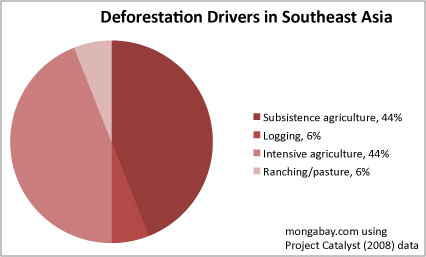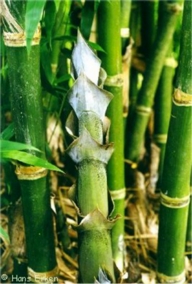The rainforests of Southeast Asia are under constant threat from detrimental human impact/involvement. Most notoriously, the region's forests are endangered and threatened by conversion to agriculture, logging (both legal and illegal), and encroaching oil palm plantations. The human impacts on the rainforests in Southeast Asia have driven many endemic tropical plant and animal species to the brink of endangerment and even extinction. This grave loss of biodiversity has disturbed the equilibrium of the species endemic to the tropical rainforest ecosystem which has subsequently resulted in a biological catastrophe. Humans have also promoted widespread deforestation in the tropical rainforests of Southeast Asia by advocating and supporting industries (such as that of timber, palm oil, and agriculture) that are directly involved in the mass, commercial removal of tropical trees.
Figure 1: Factors Driving Deforestation in Southeast Asia
 |
| Source: Mongabay.com |
Human driven deforestation in Southeast Asia has produced impacts on its rich and unique biodiversity, with Singapore being the most intensively affected country. The most immediate impact of human logging activities is the destruction of the unique multi-layered tropical forest canopy. Logging in both Borneo and Malaysia has adversely impacted the species richness of trees; seedlings in logged locations were discovered to be especially nutrient poor, implying that logged forests require a longer duration of time to recover their initial richness of species. Logging in the tropical forests of Southeast Asia has posed a particular problem because of the high density of commercially valuable tree species that this region contains. Logging and timber production have been major sources of deforestation in the lowland forests where the high proportion of desirable timber species is prevalent, make these regions ideally susceptible to the devastating effects of the logging industry. Illegal logging has also produced a "biological catastrophe" in Indonesia by negatively affecting thousands of endemic plant and animal species, and subsequently disturbing the natural balance the biological equilibrium that keeps a rainforest stable and healthy. Legal and illegal logging has prompted the loss of a multitude of "forest refugia" (or wildlife reservoirs) in the Southeast Asian rainforests, which are crucial to the replenishing of tropical plant and animal species. The timber industry has also catalyzed the fragmentation of habitats; in the future this fragmentation will promote the loss of multiple species whose roles (which include the provision of essential ecological services such as seed dispersal and pollination) are critical to survival of the Southeast Asian tropical rainforests. Once these crucial species are driven into complete extinction, the rainforest ecosystem of Southeast Asia will collapse and cease to exist. (Catalyst Magazine 2004)
 |
| Figure 2: Population extinctions in Southeast Asia and Singapore. Green and blue bars represent recorded and inferred extinctions in Singapore, respectively. Yellow and red bars represent minimum and maximum projected extinctions in Southeast Asia respectively. Source: Trends in Ecology and Evolution, Sodhi, Koh, Brook, Ng. |
|
|
Palm-oil, a popular ingredient utilized in commercial food products, has rapidly become a global commodity and a source of destruction for the rainforests of Southeast Asia. In the last decade alone the production of this commodity has more than doubled and the land area harvested for palm oil (in the rainforests of Southeast Asia) has tripled. Palm oil plantations not only account for the rapid rate of deforestation and forest degradation in Southeast Asia, but they also represent a disproportionately large source of global warming emissions. These emissions arise from the copious amounts of carbon dioxide and methane released into the atmosphere from the decaying soil beneath the established plantations. The increase in human involvement in the rainforests through the advancement of palm oil plantations, along with the expansion of logging, agriculture, and urbanization, has produced devastating effects on the tropical rainforests of Southeast Asia by facilitating a decline in species richness and biodiversity, rampant deforestation, and an overall deterioration of the ecological well-being of the rainforest ecosystem. (Trends in Ecology 2004)
Figure 3: Future expansion of palm oil in Indonesia.
 |
| Source: Vital Forest Graphics |














